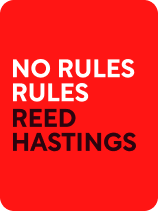

This article is an excerpt from the Shortform book guide to "No Rules Rules" by Reed Hastings. Shortform has the world's best summaries and analyses of books you should be reading.
Like this article? Sign up for a free trial here .
What is talent density and why is it important? How did Reed Hastings focus on increasing the concentration of talent at Netflix?
Talent density is a measure for the ratio of talent per employee. If you have people that are at the tops of their respective fields, your concentration of talent is much higher.
Read more about talent density and how it was cultivated at Netflix.
Talent Density at Netflix
The 2001 dot-com crash came just a few years after Hastings launched Netflix in 1998. When the dot-com bubble burst, venture capital funds dried up and Hastings was forced to lay off a third of his 120 employees. Some of the layoffs were clear-cut decisions, but many other laid-off employees had adequate performances, worked hard, and produced high-quality work despite pessimistic attitudes. Eventually, Hastings whittled his staff down to the 80 most talented and collaborative employees.
Although Hastings feared that the layoffs would decimate morale, he discovered that his staff was buzzing with energy and producing high-quality work—despite the fact that the company was still slogging through the budget cuts and the remaining employees had to carry the workloads of their former coworkers. Hastings soon realized that by eliminating less-than-stellar workers, he’d raised the talent density, meaning that there was a higher level of talent per employee, and that created an environment in which top performers thrived.
Pay Top Dollar for Top Talent
In Part 1, we saw how Hastings established high talent density, candid feedback, and limited controls to create a culture of Freedom and Responsibility in his young company. In Part 2, we explore how he employed new strategies to maintain those principles as Netflix’s growth and success altered the working dynamics. His staff had already proven the value of having a high talent density—but Netflix employees were so talented that other companies threatened to poach them. Hastings realized he would have to pay top dollar to maintain the company’s high talent density.
Pay Top-of-Market Salaries
When it comes to how much to pay employees, the answer is simple: More than anyone else. Hastings knew that Netflix had to pay enough not just to attract the highest-performing employees, but also to prevent them from being poached. Since the rock-star principle and his focus on a high talent density left him with a lean staff, Hastings made it a priority to pay his employees more than any other company would offer them—even if it was more than the employee asked for.
By contrast, most companies count on job candidates to undervalue themselves, which allows them to pay people below their value. However, as employees’ skills grow and they become more valuable, it’s often inevitable that they’ll get job offers with higher salaries. Even if workers love their jobs, research shows that most people will change jobs for more money. As a result, this model ultimately decreases talent density by creating an environment that encourages employees to leave for better-paying jobs.
Paying Top-of-Market Is Difficult, but It’s Worth the Investment
It takes a lot of time and money to pay top-of-market, but the long-term benefits are worth the short-term costs.
Problem #1: In order to pay top-of-market salaries, managers must constantly know their employees’ market values. This is a difficult task—especially in a rapidly changing market—and it requires managers to spend a lot of time researching and asking people how much they pay employees or earn themselves, which few people are willing to divulge.
Answer #1: Although researching employees’ market values is time-consuming, it takes less time than finding and training a replacement for an employee who’s been poached by a higher-paying company. Additionally, Netflix relies on employees to know their own value and to share that information with their bosses. Netflix urges employees to tell their supervisors if they find another company offering more money for the same position so that Netflix can raise the employee’s pay accordingly.
One of the best ways for employees to know their value is by talking to recruiters. Whereas other companies consider it an act of disloyalty to interview for another job, Hastings and the rest of the executive staff encourage their workers to take headhunters’ calls and even interview for jobs in order to find out what their skills are worth. Employees are then instructed to share that information with their managers. Additionally, Netflix urges managers to be proactive by giving raises before employees come to them with other offers.
Although it sounds risky to encourage employees to talk to recruiters and interview for other jobs, fostering transparency gives Netflix an opportunity to keep its workers. If managers discourage employees from talking with recruiters, it doesn’t necessarily prevent them from doing so—they simply feel that they have to sneak around. Then, if an employee receives an enticing offer, she’s more likely to accept it before telling her manager that she’s leaving. By contrast, in an open environment like Netflix, the employee can feel comfortable coming to her manager with another job offer, which gives the manager an opportunity to raise the employee’s salary and fight to keep her.
Problem #2: Giving raises that keep employees’ salaries top-of-market is expensive.
Answer #2: Although it’s expensive to pay top dollar, it’s worth the investment to attract and keep the best talent. Ultimately, it costs more to lose employees to higher-paying jobs, recruit candidates, and train new hires. However, if the company’s budget gets squeezed and managers are forced to trim payroll expenses, in order to keep the talent density high, Netflix opts to cut employees rather than reducing salaries.

———End of Preview———
Like what you just read? Read the rest of the world's best book summary and analysis of Reed Hastings's "No Rules Rules" at Shortform .
Here's what you'll find in our full No Rules Rules summary :
- How Netflix achieved massive success in a short period of time
- The unusual business practices that have helped Netflix sustain its success
- Why Netflix fires adequate employees






